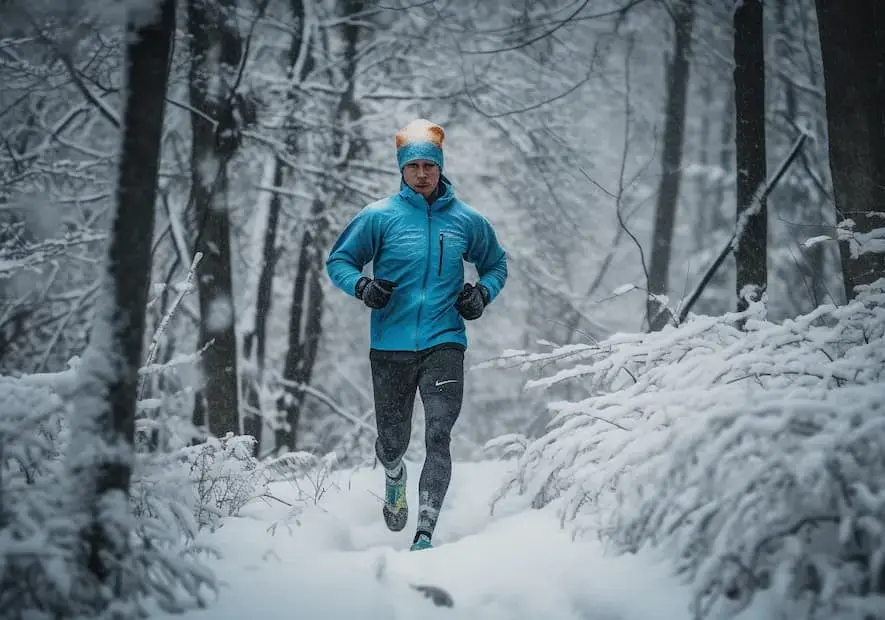Running in winter: how to equip yourself?

- 1. Embracing the Winter Run: An Overview
- 2. Essential Winter Running Gear: Dressing the Part
- - Importance of layering for winter running
- - Head and face protection for extreme conditions
- - Choosing the right footwear for snowy and icy routes
- - Keeping your hands and feet warm: gloves and thermal socks
- - Reflective clothing for visibility in winter conditions
- 3. Preparing to Run in Winter: Safety First
- - Warm up routine adjustments for colder temperatures
- - Identifying safe routes for icy conditions
- - Importance of hydration in cold weather running
- - Running with a partner for safety
- 4. Nutrition Tips for Winter Running
- - Fuelling your body properly for cold conditions
- - Hydration essentials: Debunking winter hydration myths
- - Post-run nutrition to boost recovery in winter
- 5. Dealing with Common Winter Running Challenges
- - Recognizing the symptoms of frostbite and hypothermia
- - Coping with shorter daylight hours
- - Breathing techniques to make winter running more comfortable.
- 6. Embracing the Cold: Psychological Approaches to Winter Running
1. Embracing the Winter Run: An Overview
Winter running might seem like a harsh task to many, but hold on before you abandon your running shoes this chilly season. It's true, running in the frosty outdoors comes with its unique set of challenges - biting cold winds, slippery routes and shorter daylight hours to name a few. However, let's not ignore the immense benefits that winter running brings to the table. Less heat stress, increased endurance and burning more calories are just a few perks cold weather running offers. Remember, challenges only make us stronger, and winter running is no different. It’s all about having the right mindset and being prepared with the right gear, safety measures and nutrition to turn this seemingly daunting task into an enjoyable and rewarding experience. So, are you ready to embrace the winter run? You'll be surprised at how invigorating and refreshing it can be!
- Understanding the challenges of winter running
Running during the winter months presents a unique set of challenges that can test even the most seasoned athletes. Winter weather conditions like icy paths, freezing temperatures, and limited daylight hours can seem rather daunting. Unlike the comfortable running conditions of spring or summer, winter running requires additional preparation and determination. Running on frozen or slippery surfaces raises the risk of falls and consequent injuries. Not only that, but exposure to bone-chilling weather can also lead to conditions like frostbite or hypothermia if you're not adequately protected. Moreover, the reduced daylight hours in winter months mean less visibility which adds an extra layer of difficulty. Monitoring weather forecasts also becomes crucial, unpredictable snowfall or storms can disrupt your running schedule or even pose safety threats. However, winter running isn’t all about difficulties or enduring harsh weather. It offers benefits that only running enthusiasts can truly appreciate. With adequate preparation, running in winter can lead to improvements in both your physical endurance and mental resilience. Embrace the cold, enjoy the scenic beauty of winter landscapes, and find satisfaction in conquering these unique challenges. After all, running is not just physical exercise, it’s a test of willpower and passion, no matter the season.
- Benefits of running in cold weather
Running in cold weather may seem daunting to many, but it is packed with an array of unique benefits that you might not have envisioned. From burning extra calories to building mental toughness, winter running can truly revitalize your fitness routine. Energy-wise, running in the cold can be a game-changer. Your body burns more calories in winter to stay warm, making your workout even more effective. Plus, it may also improve your stamina, as your lungs, heart, and circulatory system are working harder to maintain a normal body temperature. Winter runs also come with impressive mood-boosting powers. Regular exposure to cold can increase your levels of mood-enhancing hormones like endorphins and dopamine, pushing those winter blues away. Additionally, those starkly beautiful winter landscapes can offer an entirely different aesthetic experience. It provides visual stimuli that can reinvigorate your love for running. There's also an irreplaceable sense of accomplishment that comes from braving the elements and completing a frosty run. The mental fortitude you gain works wonders in enhancing your resilience, not just in your workouts, but across all aspects of life. So, by lacing up your shoes and heading out into the cold, you’re investing in a host of benefits that can go a long way in supporting your overall health and wellbeing.
2. Essential Winter Running Gear: Dressing the Part
When winter takes hold, dressing appropriately for your runs becomes ever more critical. Layering is key here - start with a moisture-wicking base layer, followed by an insulating middle layer to preserve body heat, and top it off with a wind and water-resistant outer layer. Don't forget to shield your head and face as they are particularly vulnerable in icy conditions; choose a warm, breathable running hat or balaclava. Winter running shoes are a must-have; they should have a good grip for icy paths and waterproof qualities. Remember, thermal socks and gloves can prevent frostbite effectively. And finally, due to shorter days, you're likely to run in low light. Therefore, wearing reflective clothing ensures that you are seen by motorists, crucial for your safety. Bundle up right, and winter running can be an exhilarating experience.
- Importance of layering for winter running
As the biting cold of winter manifests with full force, the importance of layering for winter running cannot be overstated. Tackling the icy sweep of the winter winds isn't a task for the fragile cotton t-shirt that's seen you through the summer. Oh no, it's far more complex. You need a well-crafted armor of layers that trap your body heat, yet provide enough ventilation to whisk away sweat. Remember, getting drenched in sweat in freezing temperatures can lead to hypothermia. Now, where do you start? Begin with a moisture-wicking base layer. This layer sits directly against your skin and should be made from 'intelligent' fabrics such as synthetics that wick away sweat efficiently. Steer clear from cotton - it absorbs moisture and takes an age to dry - not your best ally in the chilling cold. Then comes the insulating mid-layer - think fleeces or lightweight down jackets that trap warm air close to your body. Lastly, an outer shell, preferably water and wind-resistant, to protect against the elements. Do remember, the aim is to run comfortably, not recreate a sauna inside your clothes! Remember the sage advice - 'be bold and start cold.' After a few minutes on the trail, your body heat will start climbing, making your run comfortable. Balancing the right amount of layers for optimal warmth without overheating is a fine art that comes with experience. So, get out there, experiment, and find your 'just-right' winter running kit.
- Head and face protection for extreme conditions
Venturing out in the biting cold for a brisk run requires nothing short of a warrior's spirit. But take heed, fellow endurance athletes, for bracing those winter winds without proper face and head protection is simply a battle half-baked. Head and face protection is, unquestionably, of paramount significance when it comes to running in harsh winters. Not only does it instill a sense of fortitude, but it also safeguards our body's thermal equilibrium. You see, our body loses heat rapidly through the head, and the face, being highly exposed, is susceptible to the frosty wrath of winter. Therefore, investing in a good quality beanie or running hat is fundamental. The more tech-savvy amongst us might also consider a hat with built-in headphones. Now, hats off to that clever innovation, right? Next up, a thermal neck gaiter or a face mask is a runner's indispensable friend. It's like a shield, protecting your face while you dominate your icy battlefield. These accessories often come with thermal lining and moisture-wicking capabilities for enhanced comfort. But remember, folks, never compromise visibility for protection. Opt for gear that balances both. Do you have your winter running checklist ready yet?
- Choosing the right footwear for snowy and icy routes
Choosing the right footwear when facing the frosty challenge of winter running poses a dynamic twist. Winter running demands much more than standard running shoes. Navigating snowy, icy paths requires specific footwear that can grip frigid surfaces, providing stability to each confident stride. Imagine slipping on ice mid-stride– not joyful, right? Well, brands have orchestrated an array of options designed specifically for these conditions: from trail running shoes with aggressive treads to ice-gripping spikes that act like winter tires for your feet. Material matters, too. Opt for ones with thermal lining, waterproof or water-resistant features. Why freeze or drench your toes in winter slush when you can keep them snug and dry? Remember, winter running is not just a test of endurance, it is also a test of your preparedness. Therefore, lace up those winter-specific shoes and feel the difference. Whether it's a blizzard or a clear, icy morning, having the right footwear will grant you the confidence to conquer the winter run. Where standard shoes slip and trip, your sturdy winter running shoes glide and grip! Would you risk a fall or rather invest in the right pair of shoes? I'll let you decide.
- Keeping your hands and feet warm: gloves and thermal socks
Keeping your hands and feet warm during winter running is crucial yet often overlooked. Gloves and thermal socks play a significant role in ensuring comfort and safety while running under frosty conditions. Tossing on just any pair of gloves or socks won't suffice; it requires intentional selection for maximum efficacy. Gloves designed for cold-weather workouts are typically moisture-wicking, insulated, and made of breathable materials to keep your hands dry and warm. It's worth considering gloves with touch-screen compatibility for easy use of tech without exposing your fingers to the chill. Similarly, thermal socks designed for winter running offer extra warmth and cushioning. They're also designed to wick away moisture, reducing the risk of blisters and keeping your feet toasty throughout your run. And don't forget, these socks aren't just for those extra chilly days. Wearing them regularly can improve circulation, contributing to overall foot health. Remember, cold hands and feet can transform a winter run from an exhilarating experience into a miserable chore. So invest in a good pair of running gloves and thermal socks, and embrace the joy of winter running!
- Reflective clothing for visibility in winter conditions
Reflective clothing for visibility in winter conditions is a non-negotiable element of a winter running gear. As daylight decreases during these icy months, it's paramount to ensure that you're seen by others. It's less about fashion or style and more about ensuring you're safe during your winter jaunts. Reflective clothing becomes your safety armor, bouncing off the minimum light available and making you visible to motorists, cyclists, and even other runners. Just as a carpenter wouldn't go without his toolbox, a winter runner should never step outside without their reflective gear. Reflective jackets, hats, gloves, tights or shoes – you name it, there's a reflective version of it. Do not underestimate the importance of being seen. As you embark on your snowy trails or foggy routes, picture yourself as a moving beacon. The brighter you are, the safer you are. Remember, wear your reflective gear not just for you, but for others who share the road too.
3. Preparing to Run in Winter: Safety First
Safety should always be your top priority, especially when you're preparing to run in winter. Firstly, adjusting your warm-up routine is vital—cold temperatures require your muscles to have a more thorough warm-up to prevent injuries. Choosing safe routes can also save you from potential mishaps on icy paths. Another safety measure often overlooked is maintaining hydration. Yes, even in cold weather, hydration is crucial! Running with a partner not only makes the experience more enjoyable but can also be a lifesaver in unexpected situations. Remember, winter running can be an invigorating experience if you keep safety at the forefront.
- Warm up routine adjustments for colder temperatures
Adjusting your warm-up routine for chillier temperatures is paramount to not only enhancing your performance but also for safeguarding your well-being during your winter runs. Cold temperatures can make our muscles feel more rigid, and this stiffness can potentially lead to injuries if we don't warm up effectively. So, how can we adjust our routines? Firstly, increase the duration of your warm-up. That extra time spent preparing your body for the run can make the difference between a comfortable jog and a stiff, sore aftermath. It's also wise to focus on dynamic stretches that incorporate movement, as they help to increase blood flow, elevating your body temperature. Don’t discount the power of a good warm-up venue. By starting your routine indoors, you gain the initial heat to prepare your body for the colder weather outside, making the transition less shocking to your system. Remember, hydration is key, even in winter. Understanding that cold weather doesn't reduce your body's need for hydration is vital. Getting the balance right between effective warm-up and not exhausting yourself before the run is an art, but with practice, you will learn what works best for your body. Embrace the challenge that winter presents and connect with your body's needs - you'll find your winter runs can be equally, if not more rewarding than your summer strides.
- Identifying safe routes for icy conditions
Winter season warrants a shift in your routine, including the ways you choose your running routes. Identifying safe routes during icy conditions is absolutely essential for every runner out there. Don't forget, icy pavements convert a relaxing run into dangerous terrain, increasing the potential for slips and falls. So, how can you identify safe routes in icy conditions? Firstly, stick to well-trodden paths. Popular paths often see snow and ice cleared quickly, and are safer to tread on. Avoiding secluded routes would be wise, as you'd want to find help quickly if something goes wrong. Secondly, you could explore running at indoor tracks or treadmill running at home or the gym. Maintaining an up-to-date weather forecast of your area is as crucial as carrying a water bottle during the run. Lastly, don't forget to lean into the winter running experience by embracing slower paces and altered routes. Remember, the best pathway isn't necessarily the fastest or most challenging one. Instead, it’s the route that allows you to get out, get active, and return home safe and sound. Winter running is all about adaptability. So, stay vigilant, stay prepared, and most importantly, stay safe. There's a unique joy to winter running, let's embrace it with caution and care.
- Importance of hydration in cold weather running
Hydration doesn't take a backseat just because it's cold outside; revving up your winter running regimen demands an equally keen focus on replenishing body fluids. Interestingly, the importance of hydration in cold weather running is often overlooked, probably due to the misleading lack of visible sweat compared to sultrier conditions. However, quite contrary to the popular belief, winter air can actually be incredibly drying! It's literally stealing moisture from you with every frosty breath you take, thereby increasing your dehydration risks significantly. Moreover, you're still perspiring, albeit subtly, wrapped under those additional layers of clothing. You need to drink regularly and adequately even if you don't feel thirsty. Practical tips? Start hydrated, nip at a water or sports drink every 15-20 minutes during your run, and replenish those dwindling fluids post-run. How about keeping your water from freezing in sub-zero temperatures? Well, that's a runner's hack for another day! Remember, staying hydrated is not merely a summer song; it's a year-long symphony playing a pivotal role in your overall performance, energy levels, and recovery, irrespective of weather whims.
- Running with a partner for safety
Running with a partner can critically enhance your safety during those chilly winter runs. Not only does it add a layer of companionship to support your journey, but there's also the secondary bonus of someone having your back. Accountability is another perk, you’re less likely to skip a run when you know someone is counting on you for their run too. But the primary advantage is, of course, safety. When you're navigating those icy patches, having a running partner can be a lifesaver. With winter's shorter daylight hours, there's an added risk of low visibility. Running with a partner increases your collective visibility, reduces the chances of getting lost and helps ensure both of you are vigilant about potential dangers. Even in the harshest cold, running partners can monitor each other for symptoms of frostbite or hypothermia - conditions easier spotted by others. And in case of an unfortunate mishap, it's comforting to know you have someone with you to call for help. Remember, winter running is as challenging as it is rewarding, and while going solo offers its advantages, doing it with a partner when the temperature drops is simply the safer way to go. Your buddy has your back, and you have theirs. It's a win-win, wouldn't you agree?
4. Nutrition Tips for Winter Running
Fueling your body right is equally important for winter runners as maintaining your gear and running safely. In colder weather, your body needs more energy to stay warm and function effectively. Include complex carbohydrates like oats, whole grain bread, and brown rice in your meals for a steady release of energy. Not to mention, protein-rich foods like lean meat, eggs and legumes facilitate tissue repair and muscle recovery. Busting a winter hydration myth - you still need to drink plenty of fluids! The bitterly cold weather might deceive you into drinking less, but your body still loses water through sweat and respiration, even in winter. Lastly, consume warm, hearty meals post-run to replenish energy and aid faster recovery. Winter running is not just a test of physical strength but a game for the smart too!
- Fuelling your body properly for cold conditions
As a runner, keeping your engine well-fueled is essential, especially during the arduous winter months. What you feed your body significantly impacts your performance, energy levels and your capacity to withstand cold conditions. Hence, fuelling your body properly for cold conditions cannot be overstated. Carbohydrates are your ultimate ally for winter runs as they serve as the primary source of energy for your muscles. Consuming complex carbs, such as whole grains, vegetables, and legumes, provide a slower release of energy, keeping you sustained throughout your run. Protein is another key nutrient. It supports muscle repair and recovery, making it a crucial post-run dietary staple. Lean meats, dairy products, or plant-based protein sources will serve this purpose. Don't forget about healthy fats like avocado, nuts, and seeds that contribute to sustained energy reserves, particularly for longer runs. The winter cold can tend to camouflage your hydration needs, tricking you into thinking you're not as thirsty due to the cooler temperature. However, whether it's summer or winter, staying hydrated is crucial. Water helps regulate your body temperature and lubricates your joints, aiding smooth performance. And, of course, don't skip your pre-run warm-up meals and post-run recovery nutrition. So, better bundle up, fuel up, hydrate, and let's hit the snow-covered tracks!
- Hydration essentials: Debunking winter hydration myths
Winter hydration is a topic often steeped in myth and misunderstanding. Many erroneously think that the cold weather diminishes your body's need for hydration, but this couldn't be further from the truth; let's debunk these winter hydration myths. In reality, hydrate or die continues to apply, regardless of the mercury level. The cold may reduce your thirst sensation, but your body's need for fluid remains unabated. The dry winter air coupled with the physical exertion of running can actually enhance your risk of dehydration. Moreover, cold-induced diuresis, a natural process where your body urinates more in colder conditions, can lead to further fluid losses. Another widely believed wrong is that hot drinks hydrate better in winter, while all fluids, hot or cold, count towards your daily intake. So, pull on that woolly hat and lace up your trainers, but don't forget your water bottle! Remember, the road to optimal winter running performance is paved with good hydration. Pay heed to these truths and let not prevailing myths cloud your judgment. Here, getting the basics right is the key. Now, doesn't that feel like a breath of crisp winter air?
- Post-run nutrition to boost recovery in winter
After a chilly run in the frosty winter months, what you fuel your body with can greatly impact your recovery speed and success. While it's easy to crave comforting, high-carb foods post-run, it's essential to consider the balance of macro and micro-nutrients for a robust recovery. Protein, for example, is crucial in repairing and building your muscles after a strenuous run. Pair this with complex carbohydrates to replenish your energy stores and ward off fatigue. Foods like grilled chicken with brown rice, or a hearty lentil soup can be excellent post-run meals in winter. But it's not just about what's on your plate; don't forget hydration. While you might not feel as parched in the winter, hydration remains as vital as in the sweltering summer. Opt for warm beverages like herbal tea or clear broths, which not only rehydrate but also help raise your core temperature. Finally, listen to your body's signals. You've braved the cold, now give it the nourishment required to recover. The winter months can be strenuous for running, but with the right post-run nutrition, there's every chance you'll be primed and ready for your next sprint through the snow.
5. Dealing with Common Winter Running Challenges
One of the most challenging aspects of winter running is navigating common pitfalls that can make this chilly pursuit tricky. Let's begin with recognizing the dangers of frostbite and hypothermia. Awareness is key; understanding early signs such as numbness, shivering uncontrollably, or fatigue can be lifesavers. Don't forget that running in winter means less daylight, which can impact motivation as well as safety. It's not all grim! Efficient breathing techniques, such as shorter, shallow breaths, can help your lungs manage the cold air better. Practice this and you'll find that your winter run is a little less icy and a little more inviting.
- Recognizing the symptoms of frostbite and hypothermia
Running in the biting cold of winter poses not just comfort challenges, but also health ones. Whether you are a seasoned winter runner or gearing up for your first cold-weather jog, it's crucial to recognize the symptoms of frostbite and hypothermia. Frostbite kicks in when your skin and tissues freeze, due to prolonged exposure to the cold. This can occur in temperatures below freezing point. Tingly, numb, or painful sensations in your fingers, toes, nose, cheeks, chin, and ears are tell-tale signs of frostbite. Meanwhile, hypothermia describes the dangerous drop in body temperature caused by extended time spent in frosty conditions. Early signs include uncontrollable shivering, slurred speech, weak pulse, and shallow breathing. In extreme cases, one may experience confusion, drowsiness, or loss of consciousness. It is incredibly important to never ignore these symptoms. Immediate medical attention is vital in these instances. Stay safe by investing in the right gear, warming up properly, hydrating adequately, and most importantly, listening to what your body tells you. Remember: pushing through the pain is never worth putting your health at risk. Are we learning yet? It's all about balance and understanding that nature, while beautiful, can be deadly if disrespected.
- Coping with shorter daylight hours
Navigating the world of winter running presents a unique challenge with drastically shorter daylight hours. In the throes of winter, dawn breaks late and dusk arrives early, significantly reducing the window during which you can run in natural light. Consequently, it is crucial to devise strategies on coping with shorter daylight hours . Planning is the key here. Consider rearranging your training times to squeeze your run in the few hours of daylight. If you are a morning person, aim to knock out your run just as the sun comes up. Alternatively, if you prefer evenings, strive to complete your run before sunset. Smarter scheduling can make your runs safer, more enjoyable, and help you avoid feeling like a nocturnal creature. In case daylight runs are not feasible due to work obligations or personal constraints, ensure your safety during those dark runs. Include reflective gear as part of your running attire. High visibility clothing, LED lights, and headlamps can make you easily discernible to motorists, thus reducing the potential for accidents. Running during twilight hours could also mean colder temperatures. Don't forget to put on appropriate layers to keep the cold at bay. Stick to your plan, staying consistent, and safety-conscious can make running in shorter daylight hours a fulfilling endurance test rather than a daunting ordeal. Note these strategies may require you to step out of your comfort zone. Keep in mind, though, that adaptation is a vital part of any runner's journey. Remember, your resilience in the face of adversity adds to your mental fortitude, making you not just a better runner but a stronger individual as well.
- Breathing techniques to make winter running more comfortable.
Winter running can be quite exhilarating but is also a test for the lungs, especially when the temperature drops considerably. One effective breathing technique to remember is to breathe through your nose and out through your mouth. Why, you ask? Your nose warms up the air before it reaches your lungs, which is pivotal in freezing temperatures. But, it'll take time getting used to, so feel free to combine nose and mouth breathing based on what feels comfortable to you. Thermal masks are another commendable invention for winter runners. They further warm up your inhaled air, reducing the harsh effect of cold air on your lungs. However, don't keep them on for too long because over a period of time, they can lead to excessive moisture, inadvertently making you colder. During your run, maintain a more relaxed pace, and avoid pushing yourself - remember, the air is denser in the cold! This means take in shorter, shallower breaths instead of deep ones to help maintain rhythm and oxygen flow. Remember, winter running is never a race - pace yourself and breathe right, and you'll keep the winter blues and unwanted lung stress at bay.
6. Embracing the Cold: Psychological Approaches to Winter Running
Winter running is a beast of its own, but it's a beast you can tame with the right mindset. Embrace the cold, lace up your shoes and stride out bravely into the bone-chilling air. It's important to remember seasonal changes are a challenge, not a boundary. Keep your motivation high by setting reachable winter training goals and rewarding yourself when achieved. Get excited about your frosty breath, the early morning crunch of fresh snow underfoot, and the invigorating feel of winter air. Remember, cold is just a state of mind and winter running is an opportunity to prove your mettle. Wondering how to keep upbeat during dull, grey days? Try picturing yourself as an elite athlete, training in adversities, or assign special meaning to your winter runs.
- Mindset tips for enjoying your winter workouts
Diving into winter workouts requires a shift in your mental framework. As temperatures drop and daylight hours shrink, it's the fortitude of your mindset that will ultimately determine whether you lace up those sneakers or languish under the warmth of your duvet. The first step to enjoying your winter workouts is adopting the right mindset. Shun the typical mindset that views the chilling weather as a deterrent and instead, embrace it, acknowledging the refreshing change of pace and the physical challenge it presents. Running in the cold is an adventure, an exploration not just of your physical limits but also your mental resilience. Consider it an exercise of the highest oath you can take to your personal fitness, a commitment that treks on despite adversities. This approach is therapeutic, allowing each run to become a journey of self-discovery, helping you uncover strength, stamina, and spirit you didn't even realize you had. Acknowledging the beauty of winter, the whisper of falling snow, the stillness of a frozen lake, or the quiet of snow-dampened streets can inspire admiration, making your run an aesthetic experience, not a chore. Finally, track your progress to maintain motivation. Each mile you clock in grueling weather is a personal triumph, a testament to your defiance of the odds and a testament to your endurance.
- Staying motivated in the chilly months
Staying motivated to run during the chilly months can seem daunting, but it's entirely possible with the right mindset. Finding inspiration in the icy landscapes and refreshing crisp air can turn an otherwise grueling task into an adventure. Embrace the cold, don't fear it! It's so important to remember why you started this journey - reconnect with your passion for running and the benefits it brings to your physical and mental health. This way, even when the thermometer drops, your motivation won't. Routine is key, especially in the unpredictable winter months. Stick to your schedule come rain, shine, or snow. This consistency will create a habit that's hard to break. Should motivation wane, remember that every mile you run is a testament to your resilience. It's not simply running, it's proving to yourself that you can conquer any challenge thrown your way. Incorporate fun wherever you can - listen to a captivating podcast or energizing playlist. Join festive winter races in your community as a fun way to challenge yourself while fostering connections. Celebrate every victory, no matter how small. Did you brave the cold and get that run in? That’s a win! Remember, your progress isn't dictated by the weather - it's dictated by your perseverance, commitment, and most importantly, love for running.
- Celebrating your winter running wins.
Celebrating your winter running wins is not merely about crossing the frosty finish line but extends to acknowledging every small victory that comes your way. Every step you braved through the snow, each icy gust of wind you conquered, and those frozen mornings when you peeled yourself out of bed for a run, these are all triumphs to be celebrated. Embrace the chilly victories on the road; appreciate your persistence in these tough conditions. The great thing about winter running is that there are no set benchmarks – the environment is an ever-changing, dynamic challenge. Every run is a victory in its own right. Remember to reward yourself – make warming up with a hot drink post-run a ritual or indulge in a hearty meal. Document your runs, gather your frosty breath selfies and snow-capped running tracks snaps, and rejoice. These might seem insignificant, but they play a vital part in keeping your winter running motivation high. Don't underestimate the power of reflection; acknowledging your progress can fan the spark of perseverance into a roaring flame. Nurture the spirit of resilience winter running instils in you and wear it like a badge of honour. The dips in temperature may make the journey tougher, but they also make the victories taste even sweeter. So, let's celebrate those winter running wins with pride!
Running in winter requires more than just determination, but the right gear, preparation, and mindset can make this challenge an exhilarating experience. From layering strategically, choosing the right footwear, and practicing safe procedures to fuelling properly and developing a positive mindset, there's a well-planned strategy behind every winter run. Embrace the cold bravely, take health precautions, and let the winter season be a time of victory for your running journey.
What is the importance of layering for winter running?
Layering helps to maintain the body's core temperature and protects the skin from the harsh winter conditions.
What precautions should I take while choosing a route for running in icy conditions?
Choose routes that are well-lit and have been cleared of snow and ice. Avoid routes with steep hills where possible.
Is hydration still important when running in cold weather?
Yes, your body still loses water through sweating and breathing even in cold temperatures. Hydration aids in temperature regulation and muscle function.
What nutrition tips are helpful for running in winter?
Eating a diet rich in carbohydrates can provide the energy needed for running in cold weather. Consuming protein after a run can aid in muscle recovery.
How can I manage breathing comfortably in cold weather conditions while running?
Warm the air by breathing in through your nose and out through your mouth. Additionally, wear a mask or scarf to cover your mouth which can also help in warming the inhaled air.


















































Leave a comment